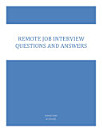Risk Analyst Interview Questions with Answers - English
About this ebook
1. Can you explain what risk analysis is and why it is important?
Answer: Risk analysis involves identifying, assessing, and prioritizing risks followed by coordinated efforts to minimize, monitor, and control the probability or impact of unfortunate events. It is crucial because it helps organizations anticipate potential issues that could affect their operations or financial stability, allowing them to implement strategies to mitigate these risks and make informed decisions.
2. What methodologies or tools do you use for risk assessment?
Answer: I use a variety of methodologies and tools for risk assessment, including:
Quantitative methods: such as statistical analysis and probability distributions to measure and predict risk.
Qualitative methods: such as risk matrices and expert judgment to assess the severity and likelihood of risks.
Tools: such as Monte Carlo simulations, risk management software (like @RISK or RiskWatch), and Excel for data analysis and modelling.
3. Can you describe a time when you identified a significant risk that others had missed?
Answer: In a previous role, I conducted a risk assessment on a new product launch. While others focused on market trends and financial projections, I identified a potential regulatory risk due to changes in compliance requirements that had not yet been fully addressed by the team. I highlighted this risk in my report and recommended a thorough review of regulatory changes, which ultimately prevented potential legal and financial repercussions.
4. How do you prioritize risks in your analysis?
Answer: I prioritize risks based on their likelihood of occurrence and potential impact on the organization. This often involves creating a risk matrix to categorize risks into high, medium, or low priority. I also consider factors such as the organization’s risk tolerance and the potential financial or operational impact when determining priorities.
5. How do you stay updated on industry trends and emerging risks?
Answer: I stay updated through continuous education and professional development. I read industry reports, follow relevant news, and participate in webinars and conferences. Additionally, I am a member of professional organizations like the Risk Management Association (RMA), which provides valuable resources and networking opportunities.
6. Can you explain a time when you had to communicate risk findings to stakeholders who were not familiar with risk management?
Answer: In one instance, I had to present risk findings to a group of non-financial stakeholders. I focused on translating complex risk data into clear, actionable insights. I used visual aids like charts and graphs to illustrate potential impacts and recommended mitigation strategies in straightforward language, ensuring the information was accessible and understandable to all participants.
7. What is your approach to developing a risk mitigation plan?
Answer: My approach involves several steps:
Risk Identification: Clearly define and document the risks.
Risk Analysis: Assess the likelihood and impact of each risk.
Mitigation Strategies: Develop and evaluate potential strategies to reduce or eliminate the risks.
Implementation: Work with relevant teams to implement the chosen strategies.
Monitoring: Continuously monitor the effectiveness of the mitigation plans and make adjustments as needed.
8. How do you handle risk management in a project with tight deadlines and limited resources?
Answer: In such situations, I prioritize risks based on their potential impact and likelihood. I focus on addressing the most critical risks that could significantly affect the project. I also collaborate closely with the project team to ensure that risk mitigation strategies are integrated into the project plan and that resources are allocated efficiently.
9. What do you think are the biggest challenges in risk management today?
Answer: Some of the biggest challenges include:
Rapidly changing regulatory environments: Keeping up with new regulations and ensuring compliance can be challenging.
Emerging risks: New technologies and global events introduce new types of risks that need to be addressed.
Data quality and availability: Ensuring accurate and timely data for risk analysis can be difficult.
10. Why do you want to work for our company as a risk analyst?
Answer: I am impressed by your company’s commitment to innovation and its proactive approach to risk management. I am excited about the opportunity to contribute my skills and experience to help navigate potential risks and support the company’s strategic objectives. Your company’s reputation for fostering professional growth and its dynamic work environment align well with my career goals.
Feel free to adjust these answers based on your personal experiences and the specific requirements of the job you’re applying for!








